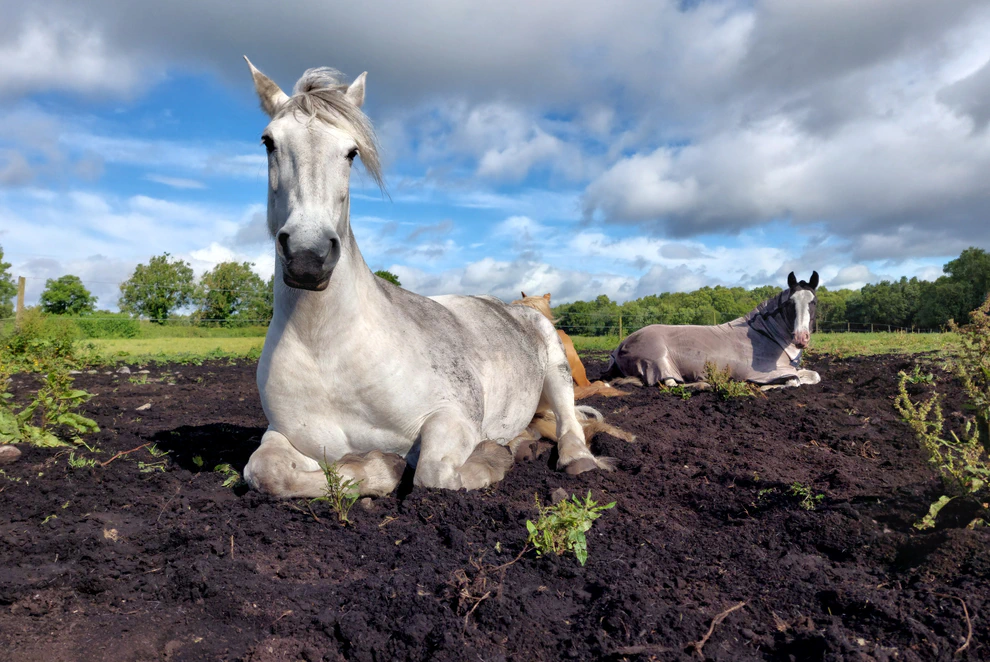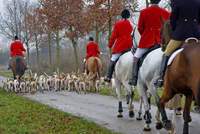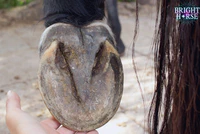Listen to the Blog-Cast:
Overcoming Fears with Desensitisation
Horses are naturally wary creatures, and this comes from the fact that they are prey animals. Their survival instincts are finely tuned to detect and react instantly to potential threats, a damn sight better than us (hello scary corner in the arena we all avoid!). Because of this, we often overlook what’s really happening when our horses stop, drop the shoulder, and spin at a shadow. From our perspective it can feel dramatic or unnecessary, so we tend to assign blame with phrases like, “It’s just a person, you’ve seen them a million times!”. But for the horse, this response is an honest reflection of their evolutionary wiring. This innate action, while crucial in the wild, often translates into fear or avoidance of new objects and situations in their human-managed lives. In other words: let’s stay away from the scary stuff, it might eat me!
In this blog, I want to explore the concept of desensitisation (which I’ll use to talk about counterconditioning and systematic desensitisation as a broad term), a science-backed approach to helping horses overcome fears. This technique builds on the principles of learning theory covered in my previous blog ‘Understanding How Horses Learn, the Language of Horse Training ’. This blog will show you how to help your horse navigate the world with greater confidence and trust. Over time, they’ll learn to approach new challenges with curiosity rather than fear. The payoff is not just fewer spooks but a horse who can think through situations instead of reacting blindly. This makes riding and handling safer, more enjoyable, and more rewarding for both horse and human.
Desensitisation is rooted in learning theory and helps horses adapt to and feel less fearful of novel or unsettling stimuli. Horses are highly sensitive to their environment, making them prone to what looks like ‘overreacting’ to perceived threats. At least it feels like an overreaction to us, to them it’s perfectly reasonable. To effectively use desensitisation in training, it’s essential to understand how horses’ evolutionary history shapes their responses and learning processes, and I would argue: be empathetic to the way they see the world compared to us humans.
Horses as Prey Animals: How Instinct Shapes Behaviour
Horses’ ancestors evolved on open grasslands, where survival depended on their ability to detect and escape predators quickly. We domesticated those ancestors and selectively bred them into the horses we see today. While this selective breeding has changed many aspects of the horse, we can’t escape their evolutionary roots as prey animals. Their entire biology is still shaped around the need to notice small changes in the environment and react instantly. What we often see as “spooky” behaviour is, in fact, the very thing that has kept horses alive as a species for millions of years.
New or unfamiliar objects can trigger a horse’s flight response, as their instinctive thought is often, “Will it eat me?” This is a logical reaction for a prey animal. Our role as trainers and caretakers is to guide horses through these fears and help them see that not everything is a threat.
This evolutionary history has left them with key traits that influence their behaviour and learning:
- Highly Reactive to Threats: Horses are hardwired to flee from danger. This flight response can be triggered by new or sudden stimuli, making training a delicate balance of managing fear and fostering trust.
- Prone to One-Trial Learning: A single negative experience can condition a horse to fear a stimulus, sometimes permanently. While this rapid learning helps in the wild, it can create challenges in training, as extinguishing these learned fears often takes considerable time and care.
- Hyperaware of Their Environment: Constantly scanning for potential threats, horses can find it difficult to concentrate on training tasks, especially in unfamiliar settings where their vigilance is heightened.
By recognising these instincts, trainers can create more effective strategies to reduce fear and build confidence in horses. This is where desensitisation (counterconditioning and systematic desensitisation) offers a more effective, humane alternative.
What is Desensitisation (counterconditioning and systematic desensitisation)?
Desensitisation, counterconditioning and systematic desensitisation, are often used interchangably in horse changing. And to see us all from going batty we have an acryonm SD/CC. For the purpose of this blog I will just call it desensitisation, because that is a term we are most likely familiar with. But understand there are differeiences between them and strengths/weakness in using one or the other in a particular case. Desensitisation involves systematically exposing a horse to a potentially frightening stimulus in small, manageable increments. The goal is to help the horse become less sensitive to the object or situation, fostering curiosity and confidence instead of fear.
Think of it as finding the sweet spot, the perfect balance where your horse is slightly uncertain but not overwhelmed (see triggered stacked below). It’s not about pushing them until they panic but instead encouraging them to take small, confident steps toward overcoming their fear. Over time, the horse learns that the scary object isn’t dangerous and begins to treat it as part of their normal environment.
This approach not only helps with obvious fears like clippers or tarps but also builds a more resilient horse who can cope better with surprises in general. A horse who learns through desensitisation is more likely to pause and think rather than bolt when faced with something unfamiliar.
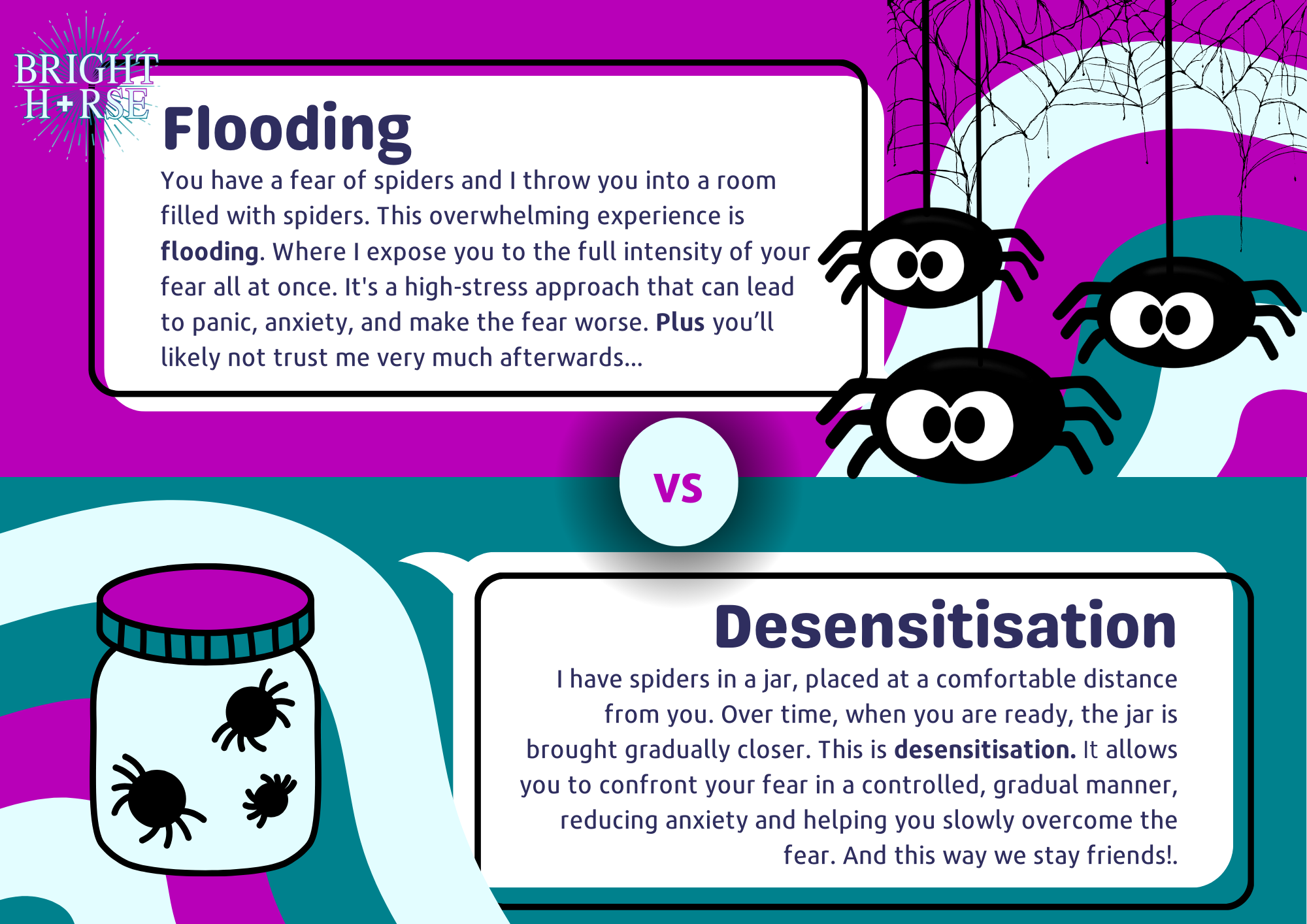
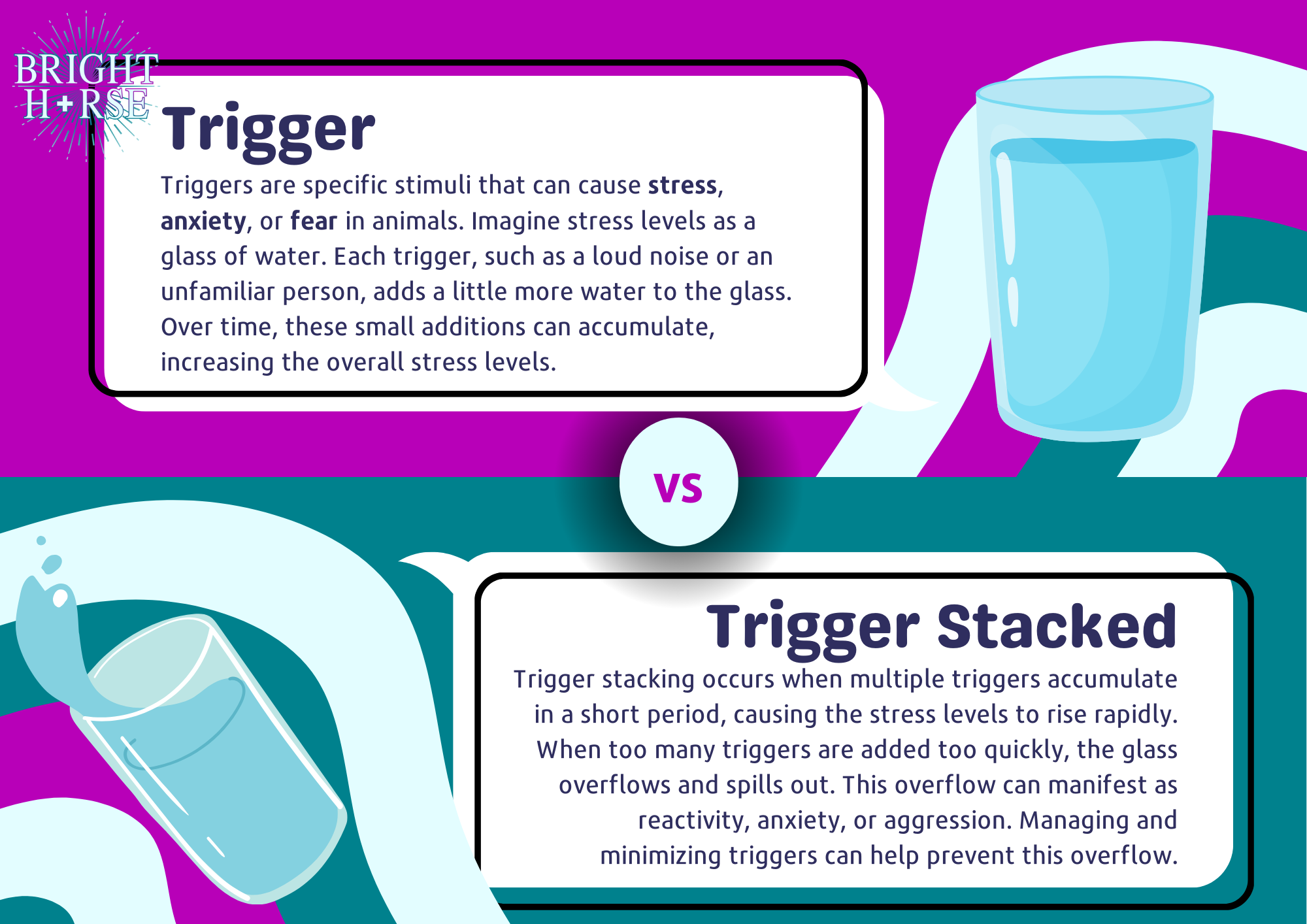
The Desensitisation Process: Step-by-Step
Move Towards the Object
Start by walking your horse toward the object at a calm, steady pace. Pay close attention to their body language. As soon as they begin to hesitate or resist, you’ve reached their comfort threshold. This is the point where their curiosity meets manageable discomfort, an ideal starting place for training.
Reinforce with Rewards (+R)
When your horse hesitates, ask for a simple step back using a gentle rein-back cue. Be patient, they may need a moment to process the situation. When they take the step back, mark the behaviour with a clear “Yes!” and offer a treat or reward. This reinforces their effort and builds positive associations with the training process.
Move Towards and Away
Repeat the approach three times, stopping at the “sticky” point and asking for a step back each time. Be mindful of your timing: release any pressure on the reins or lead rope immediately when your horse responds correctly. Mark their success with a cheerful “Yes!” and a reward.
Extend the Challenge
Once your horse is consistently comfortable at the sticky point, encourage them to take one step closer to the object. Celebrate this progress enthusiastically and reward them. Continue this process gradually, allowing your horse to approach the object step by step, always reinforcing their positive efforts.
Considerations for Effective Desensitisation
Safety: Always prioritize safety by starting with a low-intensity version of the stimulus and gradually increasing its intensity. Be prepared to step back if the horse shows signs of stress.
Consistency: Maintain a consistent approach with clear cues to help the horse understand what is expected.
Patience: Desensitisation is a gradual process. Working at the horse’s pace ensures they remain calm and engaged throughout.
Individuality: Every horse has unique sensitivities and learning speeds. Tailoring the process to the individual horse fosters better results.
By understanding the horse’s natural instincts and applying these principles of learning theory, trainers can transform fear into confidence. This approach not only helps horses overcome their fears but also strengthens the horse-human bond, creating a foundation of trust and effective communication.
Behaviours to Watch For
Throughout desensitisation, keep an eye out for signs of stress or discomfort. And please look for help from a behaviourist if your horse is struggling.
- Excessive tension - Tight, rigid muscles.
- Rapid breathing or snorting - Indicators of anxiety.
- Wide eyes and high head carriage - Signs of alertness or fear.
- Freezing - A lack of movement, indicating uncertainty.
- Evasion behaviours - Side-stepping, spinning, or backing away quickly.
If you notice these signs, reassess the challenge. I call it ‘Ask an easy question’ which basically means ask your horse an easier question you know that know that answer too without adding more of a challenge. This can help re-engage them in the task and reduce the stress. The goal is to progress at your horse’s pace, ensuring they remain calm and engaged.
Building Confidence Through Gradual Progress
By systematically and patiently working through the desensitisation process, you’ll help your horse build resilience and trust. Over time, they’ll learn to approach new challenges with curiosity rather than fear.

